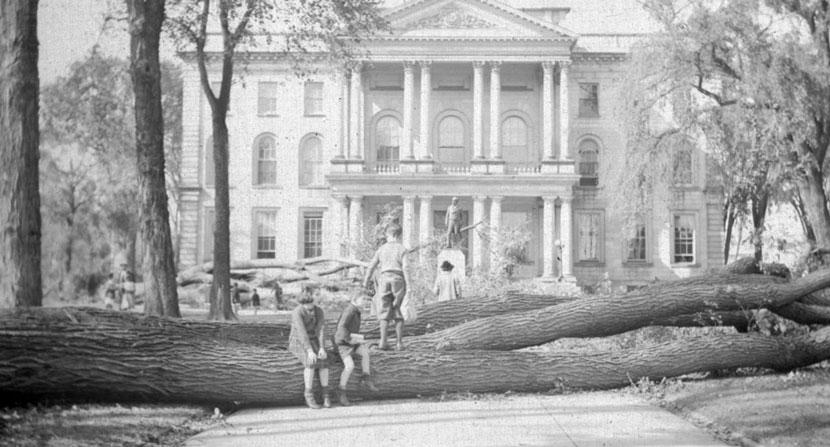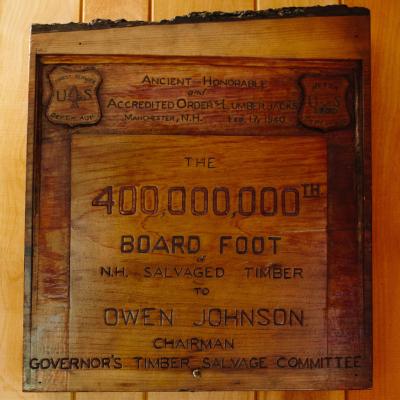A harrowing tale from the worst hurricane in New England history

Children play on the elms blown down by the hurricane at the New Hampshire State House in Concord. Photo credit courtesy the NH Division of Forests and Lands.
As I sat in my woodsy cabin, listening to the remnants of Hurricane Florence rain down this month, I was reminded of another storm nearly 80 years ago. The Hurricane of 1938 made landfall on Long Island and the southern coast of New England on September 21. While Connecticut, Rhode Island, and Long Island, NY took the brunt of the hurricane, the storm continued swiftly on a path of destruction into northern New England.

It wasn’t until over 50 years after the storm that I first learned about the Hurricane of 1938. I remember researching the hurricane for a school essay. To my surprise, my mom pulled out a VHS tape of a TV interview my grandfather gave about his experience during the hurricane. I knew my family was from Connecticut and it turned out my grandfather survived a harrowing tale on the coast. Ever since I heard his story, I’ve been curious about what is said to be the most devastating hurricane New England has ever seen.
Weathering the storm
“We didn’t realize it was going to be anything like it was,” said Barrett Dolph as he recalled his first sight of the storm’s approach. He saw a blanket of black, nothing but wind and rain. He couldn’t believe the turn of events the day had taken. My grandfather was at the barbershop earlier that morning when he got word that a storm was coming through.
A mere hour before the Great Hurricane of 1938 struck, my grandfather decided to help his good friend, Walter (Walt) Brundige, bring a boat he worked on to safety. While the skies darkened at the mouth of the Connecticut River, Barrett and Walt headed up river on a new, 60ft luxury boat to shield it from the rising water and wind. The anchor line snapped before they could cut it.
They made it to Hamburg Cove, five miles upriver from Long Island Sound. Typically, boaters must carefully navigate channels to get to the area now popular for recreation because of its quiet, protected waters. During the storm, Barrett said you couldn’t find the channel even if you wanted to. “We went right through the woods because the water level was so deep.”
The wind and rain continued into the night. “We could hear trees going down all around us, just like people were chopping them down.” They dragged anchor through the night and tried to keep calm, but the sound of trees going down all around their boat was unnerving.

The next morning, the water was clear and calm. My grandfather was shocked when they made it down river. “We saw boats piled on the docks on top of one another just like somebody had put them there.” Out of 100 boats in the harbor, only three that survived the night.
The damage continued on land as Barrett and Walt passed large elm trees down every four or five feet across the road. Meanwhile, my grandfather said people who saw them “had to look twice to make sure they weren’t ghosts.” As far as anyone knew, they drowned and the boat sank.

80 years later, much has changed when it comes to predicting and preparing for hurricanes. Meteorologists have tools and technologies to help predict storms much farther in advance. In recent years, I’ve watched live streams and videos of major U.S. and global storms from the perspectives of residents, first responders, volunteers, storm chasers, and anyone who has a smartphone and can broadcast their plight.
While we’ve gotten better at preparing and responding to storms, the future is uncertain. The last 80 or 100 years aren’t an accurate predictor for the next century. The frequency of extreme weather and hurricanes is increasing due to climate change.
My grandfather’s story made a lasting impression on me when I heard it as a child. Certain stories have the power to change us, and shape our lives years after we hear them. For me, his story is a reminder to be curious, ask questions, and seek out perspectives we would not otherwise have. If we don’t, it could be US saying, “We didn’t realize it was going to be anything like it was.”
Emily Lord manages the Society for the Protection of New Hampshire Forests’ online and social media presence. Forest Journal runs every other week in the New Hampshire Sunday News. Reach Emily at elord@forestsociety.org or on Instagram/Facebook @forestsociety.
